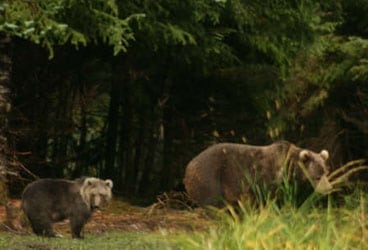
RHAlaskaBears368
As we sailed our way up the achingly remote Alaska Peninsula, I became focused on, or Diana might say obsessed with, bears. My worries that we might not encounter Ursus arctos were soon dismissed. The place is dirty with them. We took deep pleasure in sighting them from the safety of the boat, or from a comfortable distance on land, but I longed to experience the thrill and awe that only proximity can bring.
The Agrapina Bay estuary is a patchwork of chest-high grass and thick alder bushes, latticed with bear trails. Two hills lay beside each other in the valley’s center, creating a ravine that a prime salmon stream runs through. Because the Roger Henry swung in a protective bay with good holding, I suggested we all head for the hills for a little reconnoiter.
Diana demurred. Her logic was simple and irrefutable: “There are man-eating creatures out there.” Being only 19, my nephew Ryland does not reason through an idea and its consequences as well, and was therefore easily convinced to come along.
It was a bit touchy making our way through the alder patches, but we reached the base of the hill without incident and began to climb. I rounded the shoulder over the ravine, straight into a female with two cubs. This can go a couple of ways, but we became the least of her problems when a large male rumbled out of the bushes. She turned and slid down the hill with her brood in tow.
Now, exactly when does a bear sighting become a bear encounter? The hairs on the back of your neck are a good indicator. Bears have excellent sense of smell and hearing, but only moderate eyesight. The big bruin fixed those beady eyes on us, but as the wind was in our favor and we did not so much as twitch a muscle, he just couldn’t figure us out. He finally turned his attention to the succulent blueberries carpeting the tundra.
We crept back over the shoulder and breathed again. The next evening was even better. From a rock outcrop on the opposing hill we watched an absolute pig of a bear terrify every creature in the valley. The ever-alert females hid their cubs. All the lesser males had the sense to slink away from certain trouble. But he would not let them go. Grunting, swaying and spraying urine everywhere, he tracked them down and pushed them out into the valley floor. We held still as he passed right beneath us.
The sun was setting. Rule Number One: The bears own the dark. We held until we could no longer and then had to weave our way between bears to make the dingy before last light.
Our experience was growing, but luck has a lot to do with it. On Afognak Island, near Kodiak, Ry and I were walking down a dirt road. As recommended, we were talking loudly to alert bears to our presence. However, a large female with a cub did not hear us because of the noise of the paralleling stream. As we passed, she bolted into the water. But when her cub did not follow she became alarmed and aggressive. She charged up onto the road, turned toward us and started huffing. This is not good.
I turned to tell Ry to be ready to back-peddle quickly and look for a tree. Apparently Ry had already figured out that he did not have to outrun the bear, only out-run me, because his water bottle, backpack, and binoculars were already lying on the trail. This kid will go far.
Day after day and bay after bay, my focus was on those burly beasts, only occasionally diverted long enough to catch an obese salmon. But each day grew shorter, each night colder, and each gale stronger.
The seas around the Barren Islands between Kodiak and the Kenai Peninsula are described by the U.S. Coast Guard as “the third most dangerous waters in the world.” The most dangerous would be the hot water I would get myself into if I unnecessarily dragged Diana across that stretch in a blow. We agreed that, especially with Ry onboard, I would not cowboy this one, but use a passing weather window to make our passage.
We pulled out a new chart pack, lashed down the dingy, secured the anchor, set a full main, Yankee and staysail, and slid quietly between Marmot and Afognak Islands towards the open ocean.
Diana and I have sailed the ocean blue together for over 25 years. We have explored the wilds of Africa, crawled through American jungles, dove coral walls in the remote Pacific, huddled in the northern ice. I am afraid to admit it, but I have often wondered what I could possibly do next that might come even close to matching those experiences.
Again, I need not have worried. The last several weeks have been among the finest in my life. I have my beautiful wife, Diana, my loyal friend and ship’s cat, Halifax, my nephew, Ryland Jon, and perhaps even a reader or two to share all this with.
To view more photos from Alaska click here







